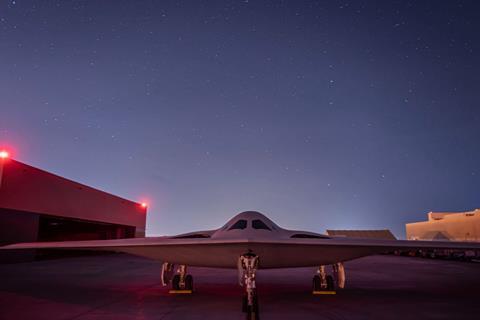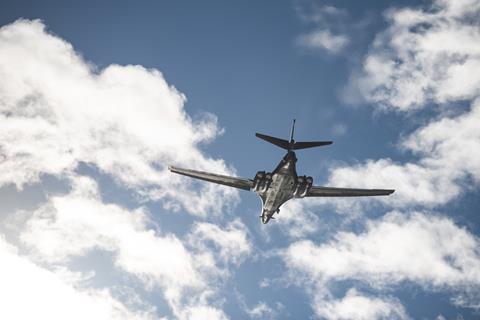Although Northrop Grumman will not deliver the first B-21 Raider until later this decade, US Air Force (USAF) aviators and ground crew are already preparing to receive the first aircraft that will roll off the assembly line in Palmdale, California.
The USAF has already selected the 28th Bomb Wing, based at Ellsworth AFB in South Dakota, to receive the first B-21s. The wing currently operates 27 Boeing B-1B Lancer bombers, which will be gradually replaced with Raiders.

“It’s going to be a huge transition from B-1, conventional-only to low-observable, nuclear capable,” says Colonel Joseph Sheffield, commander of the 28th Bomb Wing.
While the B-1B was originally designed to drop nuclear weapons, the fleet was converted to a conventional strike mission in 2011 under the New Strategic Arms Reduction Treaty between the USA and Russia.
For Ellsworth AFB and the 28th Bomb Wing, the B-21 fielding means not just preparing to receive a brand new aircraft, but also being ready to assume the hair-trigger mission of putting nuclear weapons in the sky at a moment’s notice.
To do that, Sheffield, who is qualified on the B-1 and Boeing B-52 bomber, says the base will be adding around 1,700 personnel and undertaking more than 30 military construction projects worth some $1 billion over the coming decade.
Those construction projects, some of which are already underway, include an operation and maintenance campus, a flight training unit, a facility to house flight simulators and a mission planning centre at Ellsworth.
Assuming the mission of nuclear deterrence will also require the tailored construction of a weapons generation facility and a command post with dedicated nuclear communications and control equipment, Sheffield says.
“It’s over 30 big projects,” Sheffield says. “We have six that are well underway,” he adds, noting a new low-observable hangar to house the 28th Wing’s B-21s can already be seen rising from the South Dakota prairie.
“It’s coming to fruition,” he notes.
“I think there’s a lot of aircrew that are excited about the possibility of getting to fly the B-21,” says Lieutenant Colonel Christopher McConnell, commander of the 37th Bomb Squadron at Ellsworth AFB, which falls under the 28th Bomb Wing.
While acknowledging the excitement, McConnell also notes the aviators under his command will continue operating the B-1 for some time.
“The B-1 is also not going anywhere,” McConnell says. “It’s going to remain a viable long-range strike bomber for the foreseeable future and we’re still executing… to be able to do that.”
He highlights the importance of the B-1 mission, describing the type as the USAF’s “premier” platform for launching the AGM-158 Joint Air-to-Air Stand-off Missile (JASSM), the low-observable cruise missile developed by Lockheed Martin.
McConnell also gives special attention to the B-1’s status as the only USAF platform capable of launching the Long-Range Anti-Ship Missile (LRASM), the stealthy cruise missile developed by Lockheed and the US Defense Advanced Projects Research Agency.
A wargame developed in August by the Center for Strategic and International Studies to examine potential Taiwan invasion scenarios found bomber-launched LRASMs would be critical for the US military to successfully repel a full-scale amphibious landing by the People’s Republic of China.
“We have to be ready for any threat that is out there,” McConnell says. “Whether that’s an air threat, a surface threat [or] a maritime threat.
“All of those are adapting and evolving and getting more challenging,” he adds.
In addition to new facilities, new mechanics and a new mission, the 28th Bomb Wing will also need new pilots and weapons officers to operate its B-21s.

Sheffield says the initial crop of aviators will be drawn from across the USAF’s current bomber fleet, with an eye toward pulling in as much tactical knowledge as possible into the Raider corps.
“Some [low-observability] aspects of the [Northrop] B-2, some of the nuclear aspects of the B-52, our conventional and dynamic aspect of the B-1,” he says, describing that as a “great foundation” for the B-21 force.
From there, the USAF will begin training brand new pilots on the B-21 using its existing flight instruction pipeline.
The Pentagon says it plans for the B-21 to reach initial operating capacity sometime in the middle of this decade, without providing further specifics.
According to Sheffield, once the new stealth bomber is delivered in sufficient numbers to assume the strategic bomber mission, “the B-1 and the B-2 will both sunset, and we’ll end up with a force of B-21s and B-52”.












































